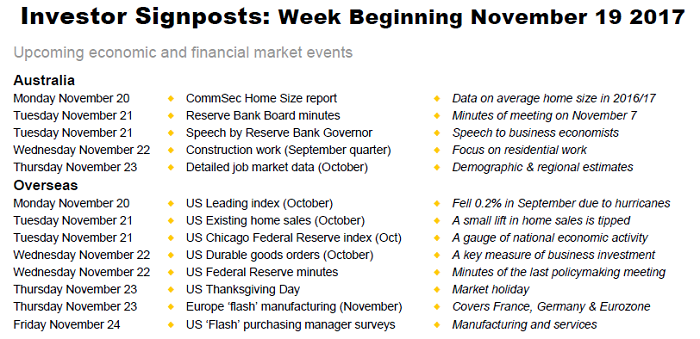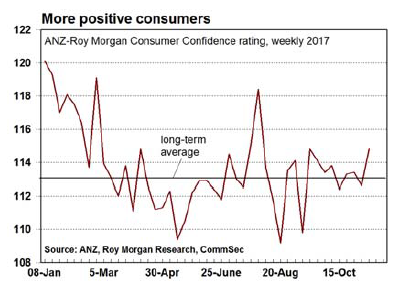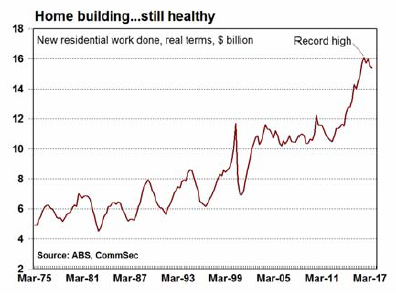Investor Signposts
A look ahead to the key economic and financial events next week.

Reserve Bank dominates proceedings
- If it wasn't for the Reserve Bank, the domestic calendar in the coming week would be decidedly thin. In the US, there are few key events in a holiday-shortened week. Minutes of the last central bank policymaking meetings are released in Australia and the US.
- The week kicks off in Australia on Monday when CommSec releases data on average floor size for new homes across Australian states and territories.
- Also on Monday there are two speeches from Reserve Bank officials. Jonathan Kearns, Head of Financial Stability, speaks at the Aus-China Property Developers, Investors & Financiers event. And Marion Kohler, Head of Domestic Markets, speaks at the Australian Securitisation Forum 2017.
- The procession of Reserve Bank officials to the podium continues on Tuesday when Michele Bullock, Assistant Governor (Financial System), speaks at the Women in Payments Symposium.
- On Tuesday, ANZ and Roy Morgan release the weekly survey of consumer sentiment. Recent data shows confidence has been tracking sideways in trend terms.

- Also on Tuesday the Reserve Bank releases minutes of the last meeting released on November 7. There will be few fresh insights. The Board released its customary statement after the meeting and on November 10 the quarterly Statement on Monetary Policy was released with updated economic growth and inflation forecasts.
- The Reserve Bank Governor, Philip Lowe, also delivers a speech on Tuesday to the Australian Business Economists annual dinner. No topic has been set as yet, but there will be plenty of questions posed by economists to the Governor.
- On Wednesday the Australian Bureau of Statistics (ABS) releases the publication “Construction Work Done” for the September quarter. The data on residential building will be included in the economic growth figures to be released on December 1. And the data on commercial building and engineering construction will provide an insight on business investment.

- Also data on skilled vacancies is released on Wednesday.
- On Thursday, the ABS releases detailed estimates on the job market including demographic and regional estimates of employment and unemployment.
- On Friday, the ABS releases new productivity estimates: “Estimates of Industry Multifactor Productivity, 2016-17”. The data will provide insights into the most productive industry sectors.
Overseas: US investors to give thanks
- It is a holiday-shortened week for economic data in the US with Thanksgiving Day celebrated on Thursday.
- The week commences in the US on Monday with the release of the leading index from the Conference Board. The leading index fell 0.2 per cent in September with the Conference Board noting it was the first fall in 12 months and said it was “partly a result of the temporary impact of the recent hurricanes”.
- On Tuesday in the US, existing home sales data for October is released. The Chicago Federal Reserve also releases its national economic activity gauge, also for October. Economists expect that home sales edged higher from a 5.39 million annual rate to 5.42 million in October.
- Also on Tuesday is the regular weekly data on chain store sales from Redbook Research.
- On Wednesday a key measure of business investment is released – durable goods orders. After rising 2 per cent in September, economists are expecting another lift in October, this time by around 0.5 per cent.
- Also on Wednesday the US Federal Reserve releases minutes of the meeting held over October 31 and November 1. Investors will be hoping for fresh insights on whether the Fed will lift rates at the final meeting for the year over December 12-13.
- Clearly Wednesday is a busy day, being the day before Thanksgiving. The usual weekly data on jobless claims – new claims for unemployment insurance – is released. And the University of Michigan releases the November estimates for consumer sentiment.
- On Thursday in Europe, the Markit organisation releases “flash” purchasing manager survey estimates for manufacturing in Germany, France and the Eurozone.
- And on Friday Markit releases the “flash” US manufacturing and services purchasing manager's survey results.
Financial markets
- The Australian sharemarket shares a common feature with other key global bourses – the past year has proved relatively more stable than average. That is, if you measure volatility as daily changes in the ASX 200 of 1 per cent or more – either up or down,
- In the past year, there have been just 26 days where the ASX 200 has risen or fallen by more than 1 per cent. That is the lowest result in just over 12 years – since the year ending September 2005.
- In data going back over 20 years, the least volatile period was the year to January 2005 when there were just nine days when the ASX 200 rose or fell more than 1 per cent.
- The most volatile period was in the global financial crisis – in the year to January 2009 there were 163 days when the ASX 200 rose or fell more than 1 per cent.
- How long this period of low volatility lasts is anyone's guess. But more stable periods tend to be more positive periods for sharemarkets – longer-term investors are put off by volatility.
Craig James is the Chief Economist at CommSec.
Share this article and show your support
















